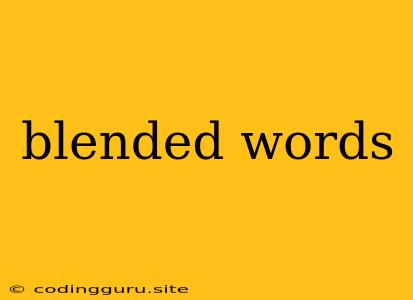The Art of Blended Words: Combining Words for Creative Expression
The English language is a living entity, constantly evolving with new words and phrases emerging every day. One fascinating aspect of this evolution is the phenomenon of blended words. These are words created by merging two or more existing words, often for the sake of brevity, humor, or a more concise way of expressing a complex idea.
But how exactly do blended words come about? What are the common patterns and techniques? And most importantly, why do they hold such a captivating allure?
The Process of Blending Words
Blended words, also known as portmanteaus or portmanteau words, are formed through a process called blending. This involves taking parts of two or more existing words and combining them into a single new word.
Here are a few common techniques for blending words:
- Combining beginnings: Smog is a classic example, formed from "smoke" and "fog."
- Combining endings: Brunch combines "breakfast" and "lunch," while motel combines "motor" and "hotel."
- Merging middle sections: Spork combines "spoon" and "fork" by using the first part of the first word and the last part of the second word.
- Using a combination of techniques: The word "chillax" combines "chill" and "relax," showcasing a mixture of merging endings and beginnings.
Why Do We Use Blended Words?
The appeal of blended words lies in their ability to convey a multitude of meanings and emotions. They can be:
- Concise: They offer a more compact and efficient way to express ideas compared to using the full phrase.
- Humorous: Blended words often create an element of playfulness and amusement, adding a touch of lightheartedness to language.
- Creative: They demonstrate a willingness to experiment with language and push the boundaries of expression.
- Descriptive: Blended words can effectively capture the essence of a concept or object in a single, memorable term.
Examples of Blended Words in Action
Blended words are woven into the fabric of our everyday language, appearing in various contexts:
- Technology: "Netbook", "Webcast", and "Wi-Fi" are all blended words reflecting the rapid evolution of technology.
- Pop Culture: "Brangelina", a combination of "Brad Pitt" and "Angelina Jolie," illustrates the use of blended words to create a unique identity for a celebrity couple.
- Slang: "Hangry", a blend of "hungry" and "angry," captures the feeling of being irritable due to hunger.
The Impact of Blended Words on Language
Blended words contribute to the dynamism and creativity of language. They reflect our ability to adapt and innovate, constantly seeking more efficient and expressive ways to communicate. They challenge traditional linguistic norms, pushing the boundaries of word formation and adding a touch of humor and playfulness to our communication.
Conclusion
Blended words, despite their seemingly simple nature, embody a rich tapestry of creativity, efficiency, and cultural influences. They are a testament to the ongoing evolution of language, showcasing our ability to adapt and find new ways to express ourselves. The next time you encounter a blended word, take a moment to appreciate its unique origins and the creative ingenuity behind its creation.
